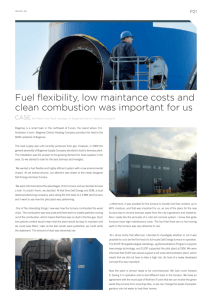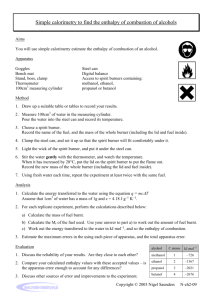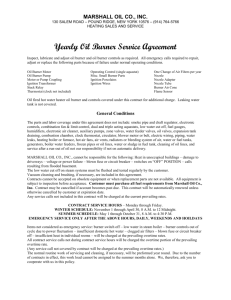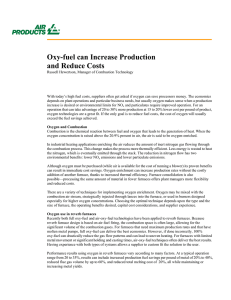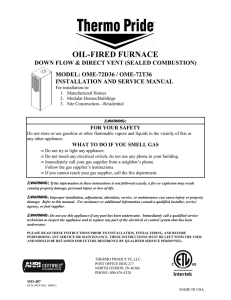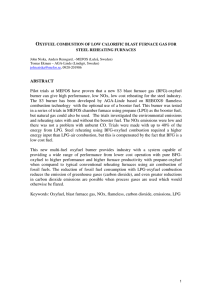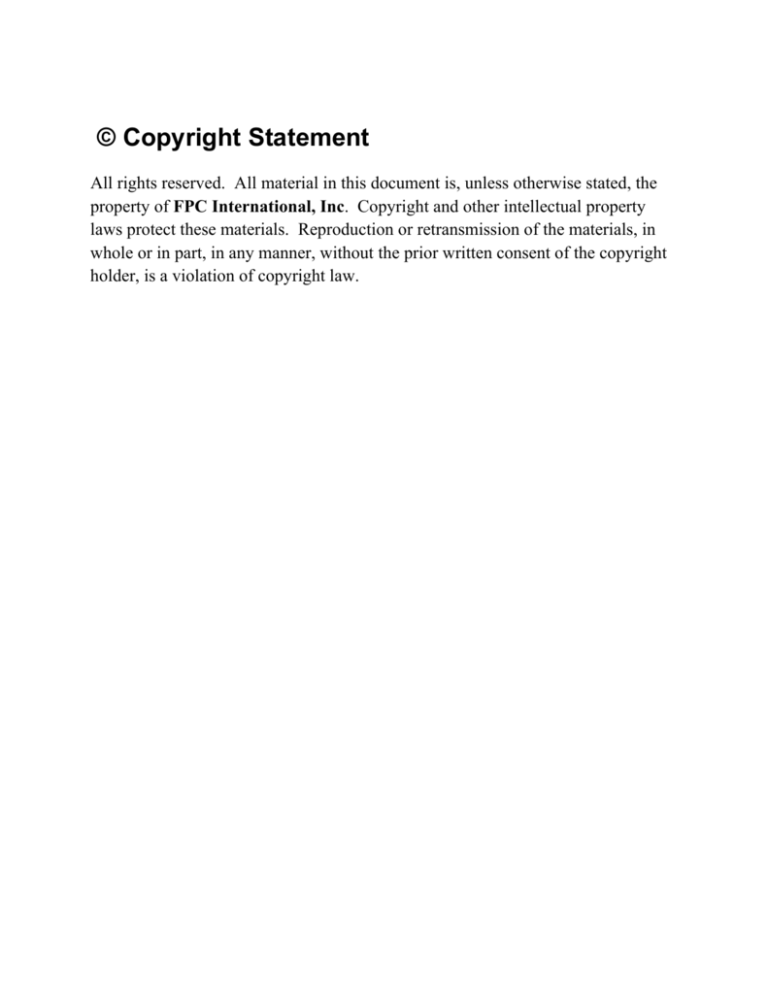
© Copyright Statement
All rights reserved. All material in this document is, unless otherwise stated, the
property of FPC International, Inc. Copyright and other intellectual property
laws protect these materials. Reproduction or retransmission of the materials, in
whole or in part, in any manner, without the prior written consent of the copyright
holder, is a violation of copyright law.
LIGHT COMMERCIAL AND RESIDENTIAL OIL HEATING SYSTEMS
WITH AND WITHOUT
FPC-1 FUEL PERFORMANCE CATALYST
TABLE OF CONTENTS
ABSTRACT
3
INTRODUCTION
3
METHODOLOGY
4
RESULTS
5
CONCLUSIONS
6
ABSTRACT
The operational costs of light commercial and residential oil heating systems have
increased over 50% in the past two years, primarily as a result of distillate fuel oil price
increases. By utilizing FPC-1 in fuel oil, a net average savings of 5 - 12% can be realized in
these heating systems.
This average net savings is made up of a combustion efficiency increase of 1 - 4%, and a
maintenance efficiency increase of 4 - 8%. The evaluation conducted in this report was
primarily designed to determine the effects of FPC-1 when added to #2 heating oil in a ratio of
1600 parts oil to 1 part FPC-1 However, studies also include; 1) the effect of FPC-1 on sulfuric
acid formation due to sulfur content in oil at different FPC-1 concentrations, 2) the cleanability
of heat exchanger and burner systems when using FPC-1 and finally, 3) operational
characteristics found in the typical on-off home heating systems.
This report will show conclusively that FPC-1 is found to be effective in improving the
overall efficiency and maintenance of oil-fired light commercial and residential heating systems.
INTRODUCTION
The typical oil-fired heating system, is under attack because of its inability, resulting
from age, to achieve and maintain maximum efficiency. It is generally recommended to obtain
maximum efficiency from an oil-fired heating system that the burner be replaced with more
efficient contemporary models. Or that the old oil furnace be scrapped in favor of natural gas
units, heat pumps or electric heat. FPC-1 Fuel Performance Catalyst, when added to the fuel oil,
can improve and subsequently maintain high furnace efficiency. The use of FPC-1 can increase
fuel efficiency in the existing burner system without substantial cost for major overhauls or
modifications.
State-of-the-art estimates indicate that the average furnace system is only 66% efficient.
Burner replacements can increase overall efficiency up to 80%. This test documents that
furnaces as old as 25 years old, can achieve an efficiency of 75-77%, with FPC-1 treated No. 2
oil and this efficiency can be easily maintained.
The testing program was designed to evaluate FPC-1 and its effect on residential and
light commercial oil-fired furnaces. However, this program was expanded to encompass the
following:
1)
To determine the acid dewpoint and rate of acid buildup in light furnaces.
2)
To evaluate, under ASTM D-2156 and D-2157 test procedures, FPC-1's effect on
smoke, and real-life adjustments.
3)
To verify the effects of FPC-1 at the following mixing ratios: 1600/1, 800/1, and
400/1.
4)
To verify the ability of FPC-1 to clean furnace heat exchanger surfaces over a
given period of time.
5)
To evaluate the effects of on/off operation on furnace efficiency and maintenance,
using FPC-1.
6)
To evaluate the effects of FPC-1 on existing sludge formations in older burner
assemblies.
7)
To determine the changes in operation of a furnace after removal of FPC-1 treated
fuel.
METHODOLOGY
The test procedures to determine combustion efficiency are found in the ASTM D-2156
and D-2157 guidelines. ASTM D-2156 is the standard test method for smoke density in flue
gases from burning distillate fuels, and involves a smoke spot test. ASTM D-2157 is the
standard test method for the effect of air supply on smoke density in flue gases from burning
distillate fuels, and, in conjunction with D-2156, monitors the efficiency of the burn of distillate
fuels.
Additional procedures used in this test are not covered by any ASTM methods. These
procedures relate to acid dewpoint and the rate of acid buildup within the furnaces. Although
ASTM has no prescribed methods for determining these factors, the procedures are accepted by
industry in general and the ASME. The procedures are recommended by Land Combustion, Inc.
while using their Dewpoint Meter Model 200.
Utilizing the above procedures as a standard format, various tests were conducted. These
tests include the following:
1)
Changing FPC-1 mixing ratios from 1600/1, 800/1, and 400/1.
2)
Visual inspection of furnace heat exchanger surfaces before and after FPC-1.
3)
Visual inspection of burner assemblies, including nozzles and strainers, before
and after using FPC-1 with emphasis on sludge and carbon deposits.
4)
Operating furnaces through an on/off sequence, typical of home usage.
5)
At the end of FPC-1 testing, untreated fuel was used again to determine any
deterioration in efficiency.
With the furnaces running at normal burner output, the following data was recorded:
Oil Flow
O2
CO2
Combustibles
Stack Temperatures
Ambient Temperature, WB/DB
Furnace Outlet Temperatures
Smoke Numbers
Rate of Acid Buildup
Burner Damper Settings
Test equipment used was:
Land Model 200 Acid Dewpoint Meter
Bacharach Continuous 02 Analyzer - Model CA-1
Bacharach 02-C02 Analyzer - Model 10-5020
Neutronics Continuous 02 Analyzer
IMC Instruments Model 6100 Digital Thermometer
Bacharach Smoke Spot Tester - Model RCC-3
Tests were conducted on the following furnaces:
Unit
No.
Manufacturer
Model #
Burner
Manufacturer
Model
Oil
Consumed
1
Carrier
58FH-106
Carrier
38M-105K401
.75 gph
2
Crane
OY 90E
Crane
MP-1192
.75 gph
3
Amer.Furnace
19-OC
Amer.Furnace
M 175-C
1.50 gph
4
Unknown
Unknown
Hallmark Oil
Burner
Baltimore, MD
Unknown
.85 gph
RESULTS
FPC-1 Fuel Performance Catalyst has shown itself to be effective in improving the
combustion and maintenance efficiency of residential and light commercial heating systems.
The table below shows various stages of furnace efficiencies.
Efficiency With FPC-1 (Date)
Unit#1
Unit#2
Unit#3
Unit#3A
Unit#4
75.2(11-25)
77.55(12-1)
74.9(12-3)
74.9(12-3)
75.3(12-1)
Efficiency Without FPC-1 (Date)
63.7(10-6)
75.20(10-22)
71.1(10-6)
67.5(11-4)
74.1(10-26)
7.33
1.2
10.8
1.6
Net Change
7.9
2.35
3.81
Percent Increase
12.4
3.1
5.1
Conditions Evaluated Per Unit
Unit #1 - Typical of current, popular design and manufacturer, Carrier Corporation, Model
58FH-106, rated at 100,000 BtuH input. Unit was run to evaluate a typical overall
efficiency gain, based on the unit as received with usual adjustments, and then
readjusted with FPC-1 and allowed to run. Unit improvement in performance is
related to the combination of combustion and maintenance efficiency.
Unit #2 - Very old burner, but a current furnace. The manufacturer was Crane Corporation,
Model OY90E, rated 100, BtuH input. This unit was run to evaluate 25+ year old
systems. This unit was completely clean at the beginning of the test. Therefore, the
efficiency increase is due only to combustion improvement.
Unit #3 &
#3A Light commercial-duty furnace, with an age of approximately 10 ten years. This type
unit is still currently available, and is manufactured by American Furnace - Model
19-OC. Extensive testing for FPC-1's ability to clean up a dirty system was performed
on this unit. The data above shows the efficiency gain from "as received" to "as
cleaned", under #3. However, the unit was made dirty by smoking, as shown under
#3A. Quick physical cleaning of sooty surfaces was performed.
Unit #4 - This unit is 25+ years old, but has the original burner, which is currently available.
The furnace manufacturer is unknown, but the burner is a Hallmark Oil Burner from
Baltimore, MD. This unit showed the least improvement in combustion efficiency.
This system was used to demonstrate that as the concentration levels of FPC-1 were
increased from 1600/1 to 400/1, the furnace efficiency did not change.
CONCLUSIONS
1)
An overall efficiency of 5-12% is possible, using FPC-1.
2)
At Smoke No.2 operating conditions, as recommended by ASTM, the use of FPC-1 will
completely clean the heat exchanger surface of carbon soot. Without FPC-1 carbon will
form and reduce the efficiency so that cleanings of a once-a-year minimum would be
required.
3)
Use of FPC-1 removed all sludge from burner strainers.
4)
Although the rate of acid buildup was already low, due to the low sulfur fuel, using
FPC-1 reduced this rate of acid buildup to '0'.
5)
Without FPC-1 three units operating at No. 2 smoke had combustibles of 0.1, or 200
ppm. When FPC-1 was added to the fuel, combustibles were eliminated.


